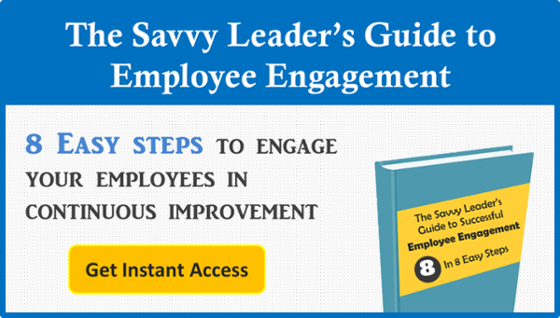 If you’re struggling to get a Kaizen culture to take root and thrive in your organization, you are not alone. We hear from people all the time in the same situation, and more often than not, they have no idea why the cultural transformation is failing. Equally common is the concern that Kaizen isn’t having the impact on the organization’s safety scores, satisfaction ratings, or bottom line that everyone thought it would. Here are some telling questions that we ask to help diagnose the problem so that Kaizen can move forward and create more of an impact in these organizations.
If you’re struggling to get a Kaizen culture to take root and thrive in your organization, you are not alone. We hear from people all the time in the same situation, and more often than not, they have no idea why the cultural transformation is failing. Equally common is the concern that Kaizen isn’t having the impact on the organization’s safety scores, satisfaction ratings, or bottom line that everyone thought it would. Here are some telling questions that we ask to help diagnose the problem so that Kaizen can move forward and create more of an impact in these organizations.
If Kaizen isn’t thriving in your organization, ask yourself these questions:
-
Who are we asking to participate?
The wrong answer: “Our process improvement team.”
The right answer: “Everybody that we possibly can, and we’re always trying to spread to more people!”
The more people you engage in Kaizen, the greater your impact will be. It’s simple, really - one person improving one thing each week has an impact of, well, one improvement per week. 500 people each improving one thing per week has a comparably huge impact. Sure, you can’t just straight from one person to 500 people, but definitely make sure you’re aligning your efforts to move in that direction. Employee engagement matters a great deal in Kaizen. -
How long is the turnaround time between when an idea is submitted and when a manager approves it?”
The wrong answer: “A couple of weeks.” Or, “I have no idea.”
The right answer: “Same day, when possible.”
If there’s too great of a time lag between when employees capture opportunities for improvement and when their managers give them the “go ahead” to work on them, momentum will be lost and less improvement will be made. Managers leveraging KaiNexus' continuous improvement software have a quick and easy way to stay on top of new ideas and minimize that turnaround time. If you don’t have continuous improvement software, make sure you have some process in place that allows you to know about and respond to all new ideas ASAP. -
How do we capture opportunities for improvement?
The wrong answer: “A suggestion box.” Or, “No formal method.”
The right answer: “Continuous improvement software.”
In order to capture and implement more opportunities for improvement for a greater impact of continuous improvement, you need to have an easy way for people to submit their ideas on the fly Continuous improvement software make that quick and easy (bonus points if it has a mobile app), helping you to make sure no ideas are lost. Whereas a suggestion box has an implementation rate of only 2-3%, continuous improvement software has a variety of features that push that implementation rate to around 80%. -
Do we broadcast the improvements we’re making?
The wrong answer: “We don’t.”
The right answer: Anything!
As long as you’re broadcasting improvements in some way, you’re on the right track. That is, assuming that your broadcast method does the following -
- Share every improvement with the right people
- Not take up very much of your precious time
- Not overwhelm people with too much email
- Keep all improvements accessible to anyone who is interested
- Connect all employees around improvement
Broadcasting improvements is important because it allows the impact of each to spread beyond its initial scope, gets more people engaged in continuous improvement, recognizes employees who are doing great work, and promotes knowledge sharing. -
What kind of improvement ideas are we asking for?
The wrong answer: “BIG! High impact. Financial returns.”
The right answer: “Small. Low-cost. Low-risk. Daily. Continuous.”
If you’re asking people to give you big, high impact ideas and devaluing daily continuous improvement, you’re taking the wrong approach to a Kaizen culture. Kaizen is all about daily continuous improvements… asking for these will result in capturing and implementing more ideas, with a much bigger overall impact than limiting the query to groundbreaking ideas. -
What rewards are we offering?
The wrong answer: “A percentage of the financial impact.”
The right answer: “Recognition in meetings, virtual badges, broadcasting success.”
Offering financial rewards for Kaizen is a common pitfall. Giving any type of financial reward actually results in a decreased number of improvements captured and implemented because:
- The reward structure only promotes improvements with a financial return.
- People want credit for their ideas so that they get the money, so they don’t collaborate.
- The focus becomes on getting money, not on improving the organization
- Improvements in areas like safety, quality, and satisfaction are undervalued
Using continuous improvement software to reward people with virtual badges and sharing their improvements is a great reward that increases engagement. People feel that their work is valued, and this is a much more effective motivator than a financial reward. So is an email from the boss, a shoutout in a meeting, and a high five in the hall! -
How often does leadership talk about Kaizen?
The wrong answer: “In an annual meeting.” Or, “Never.”
The right answer: “Every chance they get.”
Leadership that really buys into Kaizen and works to promote a culture of continuous improvement talks about Kaizen every chance they get. When they’re meeting with their staff and someone has a complaint, they suggest capturing that opportunity for improvement. When they’re speaking about the company’s mission and values, you can bet that Kaizen comes up. If they find something in their own work to apply Kaizen to, they not only do it, they talk about it too. Great Kaizen leaders drive the cultural transformation by emphasizing the value of Kaizen to the organization. They get more engagement, more improvements, and a greater impact. -
What percentage of ideas do we implement?
The wrong answer: “10 percent.”
The right answer: “80+ percent.”
If someone has identified an opportunity for improvement, chances are there really is something there that needs to be improved. Sure, they might also submit a bogus solution that’s too expensive or complicated… but viewing that as a coaching opportunity and helping them come up with a better solution results in a significantly greater impact than scrapping the whole thing does.



Add a Comment